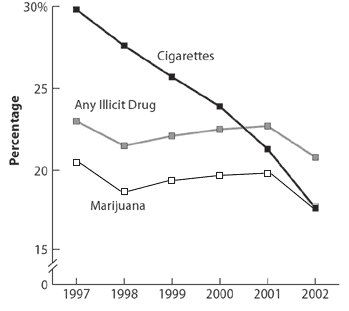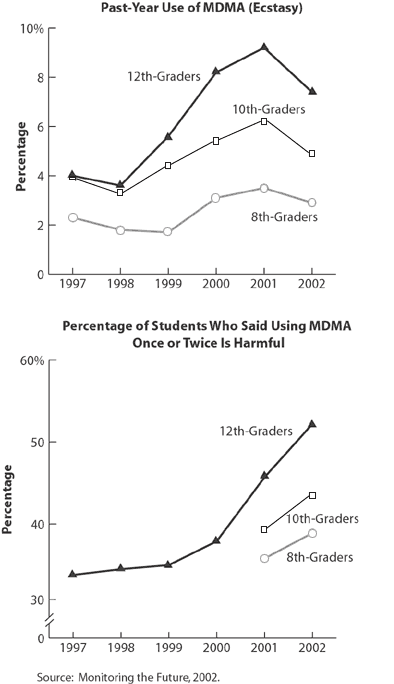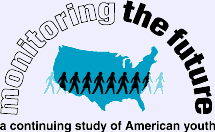Drug use by American teenagers declined in a broad range of categories during 2002, according to the latest Monitoring the Future survey. Use of MDMA (ecstasy) dropped for the first time since it was added to the annual survey in 1996, and marijuana use declined to its lowest level in 8 years. The numbers of 8th- 10th- and 12th-graders who said they had smoked cigarettes in the month preceding the survey fell by 12 percent, 17 percent, and 10 percent, respectively.
"Our science-based education and prevention efforts are paying off," said NIDA Acting Director Dr. Glen Hanson at a press conference announcing the 2002 survey findings. "Teenagers are considering the information in the messages before deciding whether or not to use drugs, and they are making better decisions. In this survey we see that teenagers are increasingly choosing not to use marijuana, not to use ecstasy and other club drugs, not to begin smoking or using alcohol. They should be congratulated."
The Monitoring the Future survey (MTF) is conducted annually by the University of Michigan's Institute for Social Research and has been supported by NIDA throughout its 27-year history. The survey tracks illicit drug use and attitudes toward drugs among 8th-, 10th-, and 12th-grade students. The 2002 study surveyed a representative sample of more than 43,000 students in 394 schools across the Nation. Students are asked about their attitudes toward drugs (Do they perceive a risk associated with trying the drug? Do they approve or disapprove of someone's trying the drug?) and about lifetime, past-year, and past-month drug use. ("Lifetime" refers to use at least once during a respondent's lifetime. "Past year" refers to an individual's drug use at least once during the year preceding their response to the survey. "Past month" refers to an individual's drug use at least once during the month preceding their response to the survey.)

Overall drug use -- the proportion of students who reported using any illicit drug in the preceding year -- declined in grades 8 and 10. "This is the first time since 1998 that we have seen a significant decline in overall illicit drug use among 10th-graders," said Dr. Lloyd Johnston, MTF principal investigator.
MTF results for 2002 show that teenagers' attitudes about drugs are changing. Compared with 2001, this year more students in grades 10 and 12 said they believed use of MDMA once or twice is harmful, and the proportion of students who said they disapproved of trying MDMA increased in all three grades. "We are gratified, but not satisfied. NIDA will continue to generate and disseminate science-based information that leads to increases in understanding of the harm that comes from drug use," said Dr. Hanson.
"These changes in perceived risk and disapproval are encouraging indicators of future downturns in drug use," Dr. Johnston observed. "This has proven to be the case with ecstasy. In 2000, only 38 percent of seniors said there was great risk of harm associated with trying ecstasy. That jumped to 48 percent in 2001 and increased again to 52 percent in 2002. These unusually rapid changes no doubt reflect the effects of media coverage of adverse events as well as NIDA's efforts to document and disseminate information about the adverse consequences of using ecstasy."
 Past-Month Drug Use by 10th-Graders Declines Monitoring the Future survey results show that teen drug use declined in 2002. Tenth-grade students reported significant reductions in overall drug use and in use of marijuana and cigarettes.
Past-Month Drug Use by 10th-Graders Declines Monitoring the Future survey results show that teen drug use declined in 2002. Tenth-grade students reported significant reductions in overall drug use and in use of marijuana and cigarettes.Similarly, the decreases in smoking reported for 2002 follow increases in the proportion of students who perceived a negative image of smoking. Roughly half of students in all three grades said they strongly agree with the statement "I dislike being near people who are smoking." Perhaps more important to teens, Dr. Johnston noted, is the social implication of changing attitudes toward smoking. "Roughly three-quarters of boys and girls in all three grades said they prefer to date nonsmokers. It now appears that taking up smoking makes a youngster less attractive, just the opposite of what cigarette advertising has been promising."
 MDMA Use Down, Perceived Risk Up Use of MDMA (ecstasy) declined sharply among all teenagers in 2002, reversing 3 years of increased use. The decrease in use follows increased perception among teens that MDMA use has harmful consequences.
MDMA Use Down, Perceived Risk Up Use of MDMA (ecstasy) declined sharply among all teenagers in 2002, reversing 3 years of increased use. The decrease in use follows increased perception among teens that MDMA use has harmful consequences.Significant changes reported in the 2002 MTF survey include the following:
- Marijuana -- Among 10th-graders, marijuana use in the past year and past month decreased, and daily use in the past month was down. Past-year use decreased from 32.7 percent to 30.3 percent; past-month use went from 19.8 percent to 17.8 percent; and daily use in the past month declined from 4.5 percent to 3.9 percent.
- Cocaine -- Crack use showed a significant increase in past-year use among 10th-graders, returning to around its 2000 level following a decline in 2001. For 2002, 2.3 percent of 10th-graders reported past-year use of crack cocaine, compared with 1.8 percent in 2001 and 2.2 percent in 2000.
- Opiates -- For the first time, MTF asked students about nonmedical use of the prescription painkillers OxyContin and Vicodin. Past-year use of OxyContin without a doctor's order was reported by 1.3 percent of 8th-graders, 3.0 percent of 10th-graders, and 4.0 percent of 12th-graders. Nonmedical use of Vicodin in the past year was reported by 2.5 percent of 8th-graders, 6.9 percent of 10th-graders, and 9.6 percent of 12th-graders.
- Inhalants -- Lifetime, past-year, and past-month use of inhalants decreased among 8th-graders, and lifetime use decreased among 10th-graders. Lifetime use went from 17.1 percent in 2001 to 15.2 percent in 2002 among 8th-graders and from 15.2 percent to 13.5 percent among 10th-graders.
- LSD -- LSD showed major changes from 2001 to 2002. Rates of use decreased markedly in each grade and reporting period. Past-year use, for example, declined from 6.6 percent to 3.5 percent among 12th-graders, from 4.1 percent to 2.6 percent among 10th-graders, and from 2.2 percent to 1.5 percent among 8th-graders. These are the lowest rates of LSD use in the history of the survey for each grade.
- Club Drugs -- Rates of MDMA (ecstasy) use decreased significantly among 10th-graders. Their past-year use declined from 6.2 percent to 4.9 percent, and past-month use went from 2.6 percent to 1.8 percent.
Findings from the 2002 MTF report are available through NIDA's Web site and at the MTF Web site, http://monitoringthefuture.org.

